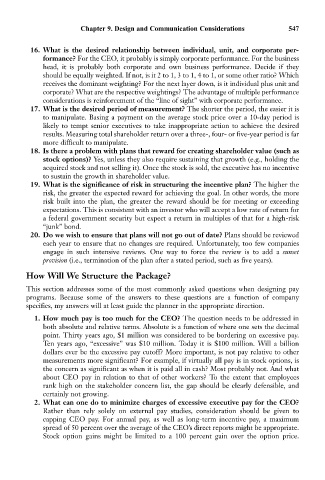Page 561 - Bruce Ellig - The Complete Guide to Executive Compensation (2007)
P. 561
Chapter 9. Design and Communication Considerations 547
16. What is the desired relationship between individual, unit, and corporate per-
formance? For the CEO, it probably is simply corporate performance. For the business
head, it is probably both corporate and own business performance. Decide if they
should be equally weighted. If not, is it 2 to 1, 3 to 1, 4 to 1, or some other ratio? Which
receives the dominant weighting? For the next layer down, is it individual plus unit and
corporate? What are the respective weightings? The advantage of multiple performance
considerations is reinforcement of the “line of sight” with corporate performance.
17. What is the desired period of measurement? The shorter the period, the easier it is
to manipulate. Basing a payment on the average stock price over a 10-day period is
likely to tempt senior executives to take inappropriate action to achieve the desired
results. Measuring total shareholder return over a three-, four- or five-year period is far
more difficult to manipulate.
18. Is there a problem with plans that reward for creating shareholder value (such as
stock options)? Yes, unless they also require sustaining that growth (e.g., holding the
acquired stock and not selling it). Once the stock is sold, the executive has no incentive
to sustain the growth in shareholder value.
19. What is the significance of risk in structuring the incentive plan? The higher the
risk, the greater the expected reward for achieving the goal. In other words, the more
risk built into the plan, the greater the reward should be for meeting or exceeding
expectations. This is consistent with an investor who will accept a low rate of return for
a federal government security but expect a return in multiples of that for a high-risk
“junk” bond.
20. Do we wish to ensure that plans will not go out of date? Plans should be reviewed
each year to ensure that no changes are required. Unfortunately, too few companies
engage in such intensive reviews. One way to force the review is to add a sunset
provision (i.e., termination of the plan after a stated period, such as five years).
How Will We Structure the Package?
This section addresses some of the most commonly asked questions when designing pay
programs. Because some of the answers to these questions are a function of company
specifics, my answers will at least guide the planner in the appropriate direction.
1. How much pay is too much for the CEO? The question needs to be addressed in
both absolute and relative terms. Absolute is a function of where one sets the decimal
point. Thirty years ago, $1 million was considered to be bordering on excessive pay.
Ten years ago, “excessive” was $10 million. Today it is $100 million. Will a billion
dollars ever be the excessive pay cutoff? More important, is not pay relative to other
measurements more significant? For example, if virtually all pay is in stock options, is
the concern as significant as when it is paid all in cash? Most probably not. And what
about CEO pay in relation to that of other workers? To the extent that employees
rank high on the stakeholder concern list, the gap should be clearly defensible, and
certainly not growing.
2. What can one do to minimize charges of excessive executive pay for the CEO?
Rather than rely solely on external pay studies, consideration should be given to
capping CEO pay. For annual pay, as well as long-term incentive pay, a maximum
spread of 50 percent over the average of the CEO’s direct reports might be appropriate.
Stock option gains might be limited to a 100 percent gain over the option price.

